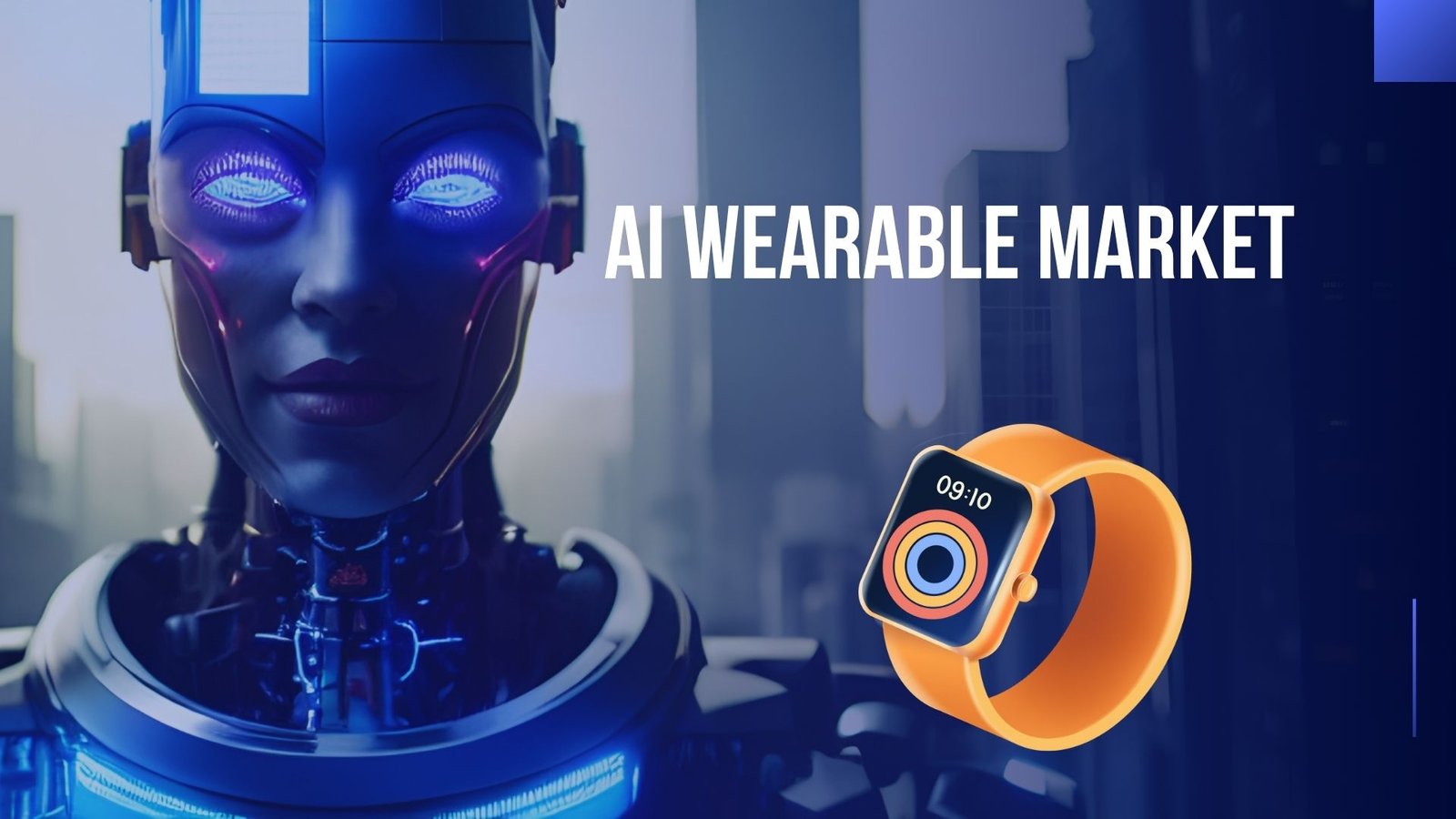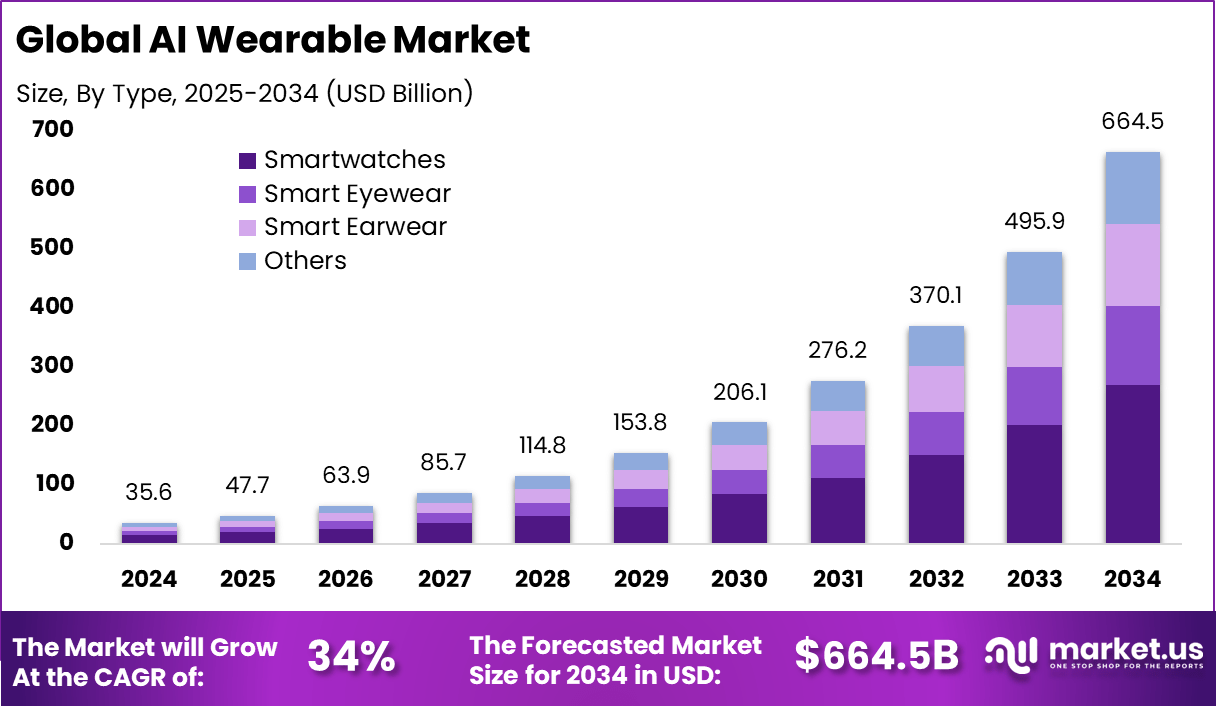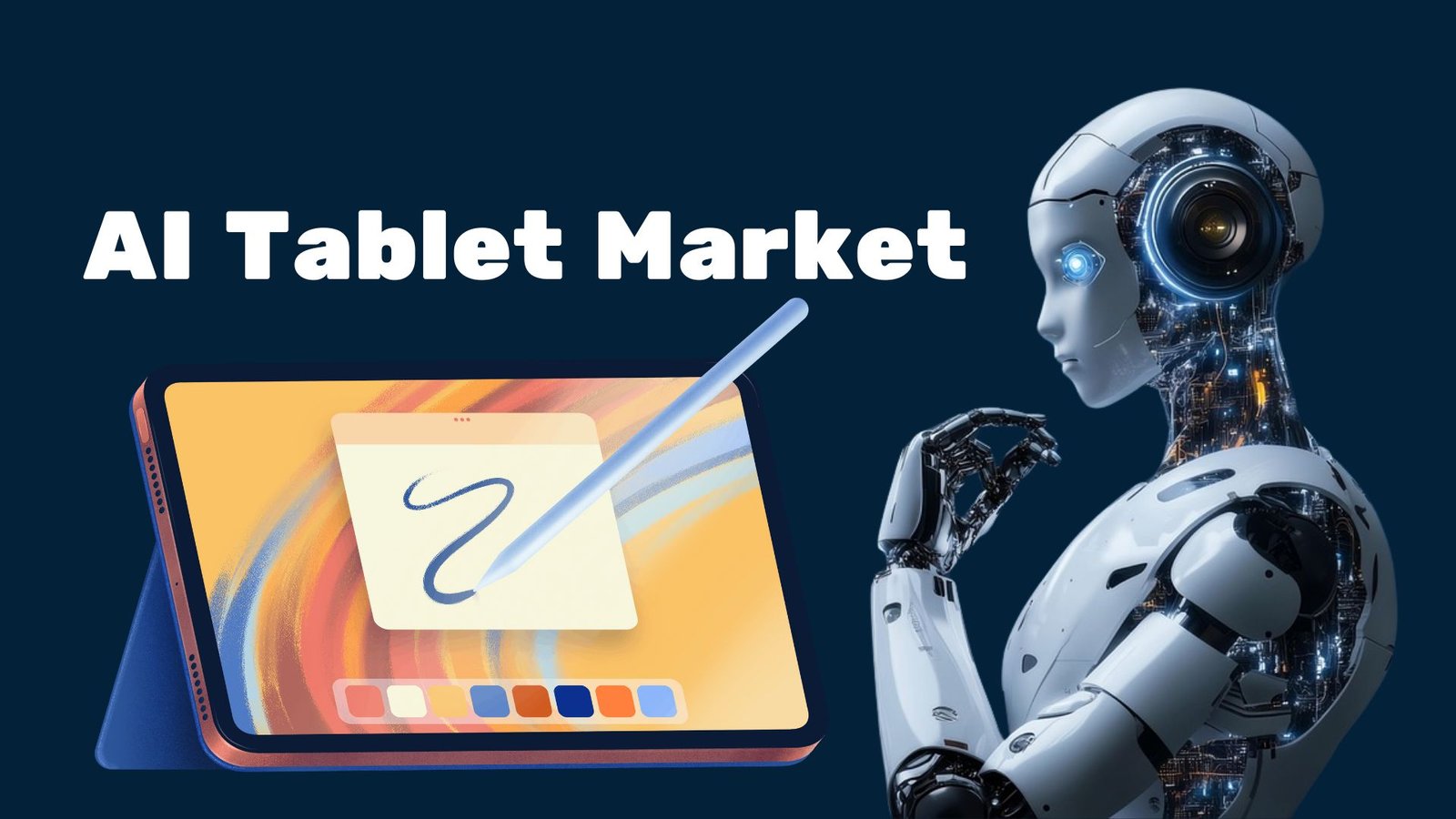AI Wearable Market Projected to Surpass USD 664.5 bn by 2034
Updated · Oct 20, 2025

WHAT WE HAVE ON THIS PAGE
AI Wearable Market Size
The global AI wearable market generated USD 35.6 billion in 2024 and is expected to grow from USD 47.7 billion in 2025 to approximately USD 664.5 billion by 2034, reflecting a strong 34% CAGR over the forecast period. In 2024, North America dominated the market with a 33.4% share, accounting for USD 11.89 billion in revenue, supported by high consumer adoption, advanced health tech integration, and strong spending on connected devices.
The AI Wearable Market is rapidly evolving, driven by the integration of artificial intelligence into wearable devices such as smartwatches, fitness trackers, smart glasses, and health monitors. These devices now go beyond basic tracking by offering real-time health insights, personalized recommendations, and enhanced connectivity. The market thrives on innovations that make wearables more efficient, accurate, and user-friendly, powered by improvements in sensor technology and AI algorithms that enable edge processing directly on the device. This evolution is expanding the use of wearables in healthcare, fitness, enterprise, and beyond, making them essential tools of daily life and work.

Top driving factors in the AI wearable market include the rising demand for personalized health and fitness monitoring, increasing awareness of chronic disease management, and growing adoption of AI-powered virtual assistants incorporated into wearable gadgets. Consumers are increasingly using wearables to track biometrics like heart rate, sleep quality, and physical activity, which AI analyzes to provide actionable insights and early warnings on health anomalies. Another notable driver is the workplace adoption of wearables to enhance worker safety and productivity through biometric monitoring and real-time alerts.
Demand analysis highlights that healthcare and fitness sectors dominate wearable AI applications, with significant growth in remote patient monitoring and chronic disease management. Users seek wearable devices that offer personalized coaching, predictive health warnings, and seamless integration with smartphones and cloud platforms. AI wearables are also gaining traction in industrial applications for safety compliance and in retail for customer service enhancements. The consumer preference for hands-free operation through voice assistants and gesture recognition further boosts demand.
Top Market Takeaways
- Smartwatches account for 40.7%, making them the most widely adopted AI-enabled wearable.
- Consumer electronics contribute 34.8%, driven by lifestyle use, personal monitoring, and convenience.
- On-device AI represents 62.6%, reflecting demand for faster processing, privacy, and offline use.
- Processors hold 54.7%, highlighting the need for high-performance chipsets in wearable tech.
- North America captures 33.4%, supported by strong spending and fast adoption of AI devices.
- The US leads regional usage with advanced consumer demand and early integration of smart features.
- A 32.4% CAGR shows growing interest in AI wearables for fitness, productivity, and entertainment.
Analysts’ Viewpoint
Increasing adoption of wearable AI technologies is fueled by advancements in low-power sensors, edge AI computing, and more affordable device manufacturing. Technologies like biometric sensors for ECG, glucose, and oxygen levels, AI-driven predictive analytics, and voice interaction are becoming standard features. Smart clothing and e-textiles with embedded AI capabilities are emerging trends that extend wearable benefits to posture monitoring and environmental sensing. These innovations are widely adopted due to their ability to provide continuous, context-aware feedback without significant user effort.
Key reasons for adopting AI wearables include improved health monitoring with early detection of diseases, personalized fitness guidance, enhanced worker safety, and hands-free convenience through virtual assistants. These devices help individuals manage chronic conditions and optimize wellness routines while enabling employers to monitor environmental and physiological data to reduce accidents. The integration of AI also increases device intelligence, allowing wearables to learn user habits and adapt the functionality accordingly, making them more useful over time.
Investment and Business benefits
Investment opportunities in this market stem from the growing health-conscious consumer base, enterprise demand for workforce monitoring, and expansion into niche segments like elderly care and sports. Advances in AI algorithms, sensor miniaturization, and IoT connectivity attract investments in device innovation and ecosystem development. The rise of specialized applications such as brain-computer interface wearables and AI-powered VR/AR headsets also provides new frontiers for funding. Investors are particularly interested in technologies enabling predictive health analytics and real-time decision support.
Business benefits of adopting AI wearables include increased operational efficiency through real-time monitoring, improved employee safety, enhanced customer engagement via smart retail wearables, and better health outcomes among users. Enterprises benefit from reduced downtime, faster response to health or safety incidents, and data-driven insights that inform business strategies. For consumers, these devices deliver convenience, personalized health care, and continuous fitness motivation, ultimately improving quality of life and work productivity.
wearable device shipment highlights
| Metric | Data |
|---|---|
| Total Shipments (2024) | 534.6 million units |
| Year-over-Year Growth (2024) | 5.4% |
| Wrist-Worn Market Growth (Q1 2025) | 10.5% year-over-year |
| Leading Wrist-Worn Vendors (Q1 2025) | Huawei, Xiaomi, and Apple |
| Top Product Growth (2025) | Hearables are expected to lead growth |
| Product Recovery (2025) | Smartwatches are anticipated to have a modest recovery |
Driver
Rising Demand for Health and Wellness Monitoring
AI wearables are increasingly popular because people want better tools to manage their health daily. Wearable devices with AI offer real-time monitoring of vital signs like heart rate, oxygen levels, and sleep quality. This helps users get personalized health insights and early warnings about potential issues. The growing awareness about health and wellness is a strong factor pushing consumers to adopt these smart devices.
Healthcare providers are also driving demand by integrating AI wearables into remote patient monitoring and chronic disease management. As these devices give continuous data that can be analyzed quickly, they help improve healthcare outcomes and reduce costs in the long term. This growing use in both consumer and medical fields is a solid foundation for market growth.
Restraint
Concerns About Data Privacy and Security
One major restraint for AI wearables is the concern over privacy and security of the sensitive personal data they collect. These devices gather detailed biometric and health information, which raises worries about how safely this data is stored and used. Consumers and regulators are increasingly cautious around data breaches and unauthorized usage.
This concern makes some potential users hesitant to fully embrace AI wearables, slowing wider adoption. Companies need to invest heavily in strong data protection measures and transparent privacy policies to build trust. Without addressing these data security issues, the market growth could be limited by user reluctance.
Opportunity
Expansion in Healthcare and Specialized Applications
There is a huge opportunity to grow AI wearables in healthcare beyond basic fitness. Advanced AI-powered devices can support remote patient monitoring, early disease detection, and personalized treatment plans. These applications are critical for aging populations and those with chronic illnesses who need ongoing care without frequent hospital visits.
Besides healthcare, AI wearables have potential in specialized fields—such as workplace safety, elderly care, and accessibility for people with disabilities. Custom devices designed for these niches can offer higher value and open new markets. As technology matures and digital health becomes mainstream, AI wearables have many paths for expanding their role and revenue.
Challenge
Battery Life and Device Usability
A key challenge for AI wearables is managing battery life while running power-hungry AI computations. Running advanced algorithms and sensors continuously drains battery quickly, forcing users to recharge often. This reduces convenience and can hurt the user experience.
Additionally, making these devices small, lightweight, and easy to use without compromising on features is difficult. Consumers want wearables that fit seamlessly into their lives, but integrating powerful AI in compact form factors strains current technology. Innovations in low-power chips and more efficient AI processing will be needed to solve these usability problems and support market growth.
Key Market Segments
By Type
- Smartwatches
- Smart Eyewear
- Smart Earwear
- Others
By Application
- Consumer Electronics
- Healthcare
- Automotive
- Military & Defense
- Media & Entertainment
- Others
By Operations
- On-device AI
- Cloud-based AI
By Component
- Processor
- Connectivity IC
- Sensors
Top Key Players in the Market
- Amazon.com, Inc.
- Fitbit, Inc.
- Garmin Ltd.
- Google, Inc.
- Huawei Technologies Co. Ltd.
- IBM
- Motorola Solutions, Inc.
- TomTom International B.V.
- Apple, Inc.
- Samsung Electronics Co. Ltd.
- Sony Corporation
- Other Major Players

Rohan is a senior editor at Techno Trenz. He knows a lot about digital marketing, SEO, and social media optimization. Rohan is great at creating and editing detailed articles with accurate statistics that readers find useful. As a senior editor, he reviews and checks the quality of content from many writers before it is published. He also makes infographics to go with the statistics, making the information easier to understand and more engaging. Rohan's hard work ensures that Techno Trenz provides high-quality and informative content to its readers.










